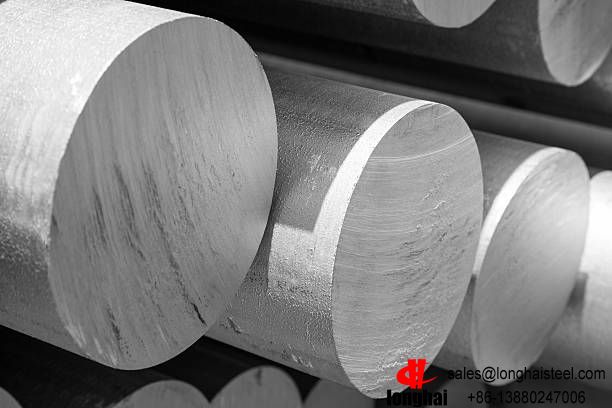
AerMet 100 (also known as Alloy 100, UNS K92580, and governed by AMS 6532 & AMS 6478B) is an ultra-high-strength steel widely used in aerospace, military, and racing applications due to its exceptional strength-toughness balance.
- Heat Treatment
- Thermal Properties
- Welding
- Machining
- Similar or equivalents steel grade
What is Alloy 100 grade steel?
Alloy 100 (also known as Aermet 100) is an ultra-high-strength martensitic steel developed primarily for aerospace and defense applications where a combination of extreme strength, toughness, and stress-corrosion resistance is required.
Comparison to Similar High-Strength Steels
| Alloy | Tensile Strength (MPa) | Toughness (MPa√m) | Key Strengths |
|---|---|---|---|
| Aermet 100 | 1930+ | 110+ | Best balance of strength + toughness + corrosion resistance |
| 300M | 1860-2000 | ~70 | High strength, but lower toughness & corrosion resistance |
| 4340 | 1500-1800 | ~60 | Widely used, but inferior to Aermet 100 |
| Maraging 250 (18Ni) | 1700-1900 | ~90 | High toughness, but lower strength than Aermet 100 |
- Aircraft landing gear (F/A-18, F-22, F-35)
- Armor-piercing components
- High-stress aerospace fasteners
- Racing & high-performance automotive parts
Why Choose Aermet 100 Over Alternatives?
- Best-in-class strength-toughness combination for critical aerospace/defense uses.
- Resists stress-corrosion cracking better than 300M or 4340.
- Used where failure is not an option (e.g., fighter jet landing gear).
Products Form:

Chemical Composition
| Grade | Chemical composition WT % | ||||||||||||
|---|---|---|---|---|---|---|---|---|---|---|---|---|---|
| C | Mn | Si | P * | S | Cr | Ni | Co | Mo | Ti | Al | O | N | |
| AerMet 100 | 0.23 | - | - | - | - | 3.10 | 11.10 | 13.4 | 1.20 | 0.05 | - | - | - |
AMS 6532 UNS K92580 | 0.21-0.25 | 0.10 | 0.10 | 0.008 | 0.005 | 2.9-3.3 | 11-12 | 13-14 | 1.0-1.3 | 0.015 | 0.015 | 20ppm | 15ppm |
| AMS 6478B UNS K92580 | 0.21-0.25 | 0.10 | 0.10 | 0.008 | 0.005 | 2.9-3.3 | 11-12 | 13-14 | 1.0-1.3 | 0.015 | 0.015 | 20ppm | 15ppm |
| Alloy 100 | 0.21-0.25 | 0.10 | 0.10 | 0.008 | 0.005 | 2.9-3.3 | 11-12 | 13-14 | 1.0-1.3 | 0.015 | 0.015 | 0.002 | 0.0015 |
* P+S: 0.010
Mechanical Properties
Room Temperature Performance
| Property | Value | Test Standard |
|---|---|---|
| Tensile Strength | 1930-2070 MPa (280-300 ksi) | ASTM E8/E8M |
| Yield Strength | 1650-1790 MPa (240-260 ksi) | ASTM E8/E8M |
| Elongation | 10-14% | ASTM E8/E8M |
| Fracture Toughness (KIC) | 110-130 MPa√m | ASTM E399 |
| Hardness | 52-54 HRC | ASTM E18 |
Fatigue Performance (S-N Curve)
- Fatigue limit (10⁷ cycles, R=0.1): 700-750 MPa
- High-cycle fatigue (HCF): Dominated by microcrack initiation at inclusions
- Low-cycle fatigue (LCF): Controlled by plastic strain accumulation
Fatigue Crack Growth Rate (Paris Law Parameters)
| Stress Ratio (R) | C (mm/cycle) | m | ΔK Range (MPa√m) |
|---|---|---|---|
| R=0.1 | 1.2×10⁻¹¹ | 3.2 | 10-50 |
| R=0.5 | 3.5×10⁻¹¹ | 3.0 | 10-40 |
Fracture Toughness & CTOD Analysis
Crack Tip Opening Displacement (CTOD)
- Critical CTOD (δm): 0.15-0.25 mm (ASTM E1820)
- Threshold ΔKth: ~5 MPa√m (below which cracks do not propagate)
Fracture Modes
- Fatigue fracture: Striations + secondary cracks
- Overload fracture: Dimples + localized cleavage (hydrogen embrittlement risk)
Microstructure Analysis (SEM/TEM/EBSD)
Key Phases in AerMet 100
| Phase | Morphology | Size |
|---|---|---|
| Lath Martensite | High-dislocation-density bundles | 0.2-0.5 μm width |
| Reversed Austenite | Thin films between laths | 10-50 nm thickness |
| M2C Carbides | Spherical precipitates | 5-20 nm diameter |
Fractography (SEM Imaging)
- Crack initiation: Often at Al₂O₃ inclusions (≤10 μm)
- Stable crack growth: Fatigue striations (~1 μm/cycle spacing)
- Fast fracture: Mixed ductile (dimples) + brittle (cleavage)
6. Environmental Effects & Special Conditions
Hydrogen Embrittlement (SSRT Testing)
- Reduction in ductility: 14% → 6% elongation (after H-charging)
- Fracture mode shift: Ductile → intergranular cracking
Corrosion Fatigue (Salt Spray Testing)
- Fatigue life reduction: 30-40% in 3.5% NaCl vs. dry air
- Crack growth acceleration: 2-3× faster at ΔK >15 MPa√m
Physical Properties
- Density (lb/in3): 0.285
- Modulus of Elasticity: 28.2 x 103 ksi
- Melting Point (°F)
- Thermal conductivity (BTU-in/hr-ft²-°F): 172
- Specific heat (BTU/lb-°F) -
- Thermal expansion (1/°F): 0.00000552
- Electrical conductivity (% IACS): 4.01
- Electrical Resistivity: 70.0° F
Heat Treatment
Decarburization
- Like other carbon bearing high strength alloys, AerMet 100 alloy is subject to decarburization during hardening. Heat treatment should take place in a neutral atmosphere furnace, salt bath or vacuum. Decarburization should be determined by comparing the surface and internal hardness of a small test cube for proper response. Metallographic determination of decarburization is not recommended for this alloy.
Normalizing
- AerMet 100 alloy can be normalized by heating to 1650° F (899° C) holding for one hour and air cooling to room temperature. Optimum softening for machining is obtained by following the 1650° F (899° C) normalize with a 16 hour 1250° F (677° C) overage anneal.
Annealing
- AerMet 100 alloy is softened by using a 1250° F (677° C) overage anneal for 16 hours. The optimum annealed hardness of 40 HRC maximum is obtained following this anneal.
Solution Treatment
- The solution treatment temperature range is 1625° F+/-25° F (885° C +/-14° C) for 1 hour. The solution treatment temperature must be monitored by a thermocouple attached to the load.
Quenching
- Water quenching is not recommended.
Proper quenching practice is essential for AerMet 100 alloy. The alloy should be cooled from the solution treatment temperature to 150° F (66° C) in 1 to 2 hours to develop optimum properties. Individual sections larger than 2" diameter to 1" thick (plate) must b quenched with oil in order to obtain 150° F (66° C) in 1 to 2 hours. Individual sections up to 2" diameter or 1" thick (plate) will air cool to 150° F (66° C) in 1 to 2 hours. The cooling rate of the furnace load must be monitored by a thermocouple attached to the hottest spot in the load to insure that the 2 hour cool to 150° F (66° C) is obtained.
Cold Treatment
- Following cooling to room temperature, to obtain the full toughness capability AerMet 100 alloy should be cooled to -100° F (-73° C) and held for 1 hour. The parts can then be air warmed.
Straightening
- AerMet 100 alloy exhibits minimal size change during heat treatment; however, for some parts, mechanical straightening to compensate
for distortion during heat treatment is appropriate.
Prior to straightening, a low temperature stress relief at 350/400° F (482/204° C) for 5 hours following the refrigeration operation will provide an optimal combination of ductility and yield strength for the mechanical straightening operation.
Age
- The standard aging treatment for AerMet 100 alloy is 900° F +/- 10° F (482° C +/- 6° C) for 5 hours. Parts made from AerMet 100 alloy should never be aged at a temperature below 875° (468° C).
| Aging Temperature | HRC |
|---|---|
| As hardened | 51.0/53.0 |
| 875° F (468° C) 5 hrs | 54.5/55.5 |
| 900° F (482° C) 5 hrs | 53.0/54.0 |
| 925° F (496° C) 5 hrs | 51.0/52.5 |
Thermal Properties
Forging
Primary break down forging of AerMet 100 alloy should be done at a maximum starting temperature of 2250° F (1232° C). Finish forging should be done from 1800° F (982° C) with a finishing temperature below 1650° F (899° C) in order to optimize the final heat treat proper- ties. Following forging the parts should be air cooled to room temperature and then annealed. Following the anneal, the forgings should be normalized in order to restore properties to the dead zone.
Welding Properties
- Welding: Avoid conventional methods—EBW/LBW + PWHT required
Machining Properties
AerMet 100 is somewhat more difficult to machine than 4340 at HRC 38. Hence, carbide tools are recommended at 280 to 350 SFM.
Following rough machining, stress relieve at 800° F (427° C) for 1-3 hours if a stress relief is desired.